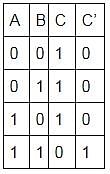Indian Army Nursing Assistant Mock Test - 6 - Indian Army Nursing Assistant MCQ
30 Questions MCQ Test Indian Army Nursing Assistant Mock Test Series 2024 - Indian Army Nursing Assistant Mock Test - 6
| 1 Crore+ students have signed up on EduRev. Have you? Download the App |
The constituents of atomic nuclei are believedto be [1991]
The truth table given below is for a gate with A and B as inputs and C as output. Which of the gates will obey this truth table?
The balanced chemical equation for the reaction of zinc metal with hydrochloric acid is:
The atomic masses and chemical properties of Sulphur and Phosphorus are different. This can be explained on the basis of:
Which of the following is not responsible for air pollution?
Which group 16 element has 8 allotropic forms?
Which of the following is a redox reaction?
Which of the following is known as soda ash?
What is the molecular formula of ethene?
Values of e/m (charge/mass) in the categories alpha particle (α), electron (e) and protons (p) increase in the order:
How many number of molecules and atoms respectively are present in 2.8 litres of a diatomic gas at STP?
Valence bond theory explains the overlapping of atomic orbitals.
The pH of a compound is found to be 9. The compound can be:
The process of converting alcohols into corresponding alkyl halides is known as:
A C-terminal KDEL sequence in the protein will most often ensure-NA
Which is the characteristic of heterotrophs?
Identify the bird that can fly over long distances?
Which of the following aquatic plants grows completely submerged in water?
Sania was asked to write about some actions which are voluntary in nature. She has written some involuntary actions too. Pick the involuntary actions written by Sania from the list given below.
(i) Chewing food
(ii) Sitting upright on a table
(iii) Digestion of food
(iv) Beating of heart
(v) Singing a song
(vi) Dancing(vii) Breathing
Diseases like malaria and dengue are spread by:
Which of the following is a water-soluble vitamin?
To solve the food problem of tfie country which among the following is necessary?
Which of the following combinations are most suitable for composite fish culture?
These blood vessels take blood away from the heart to different parts of the body. The aorta is the biggest of these vessels. Which vessels are we talking about?



 molecules
molecules














